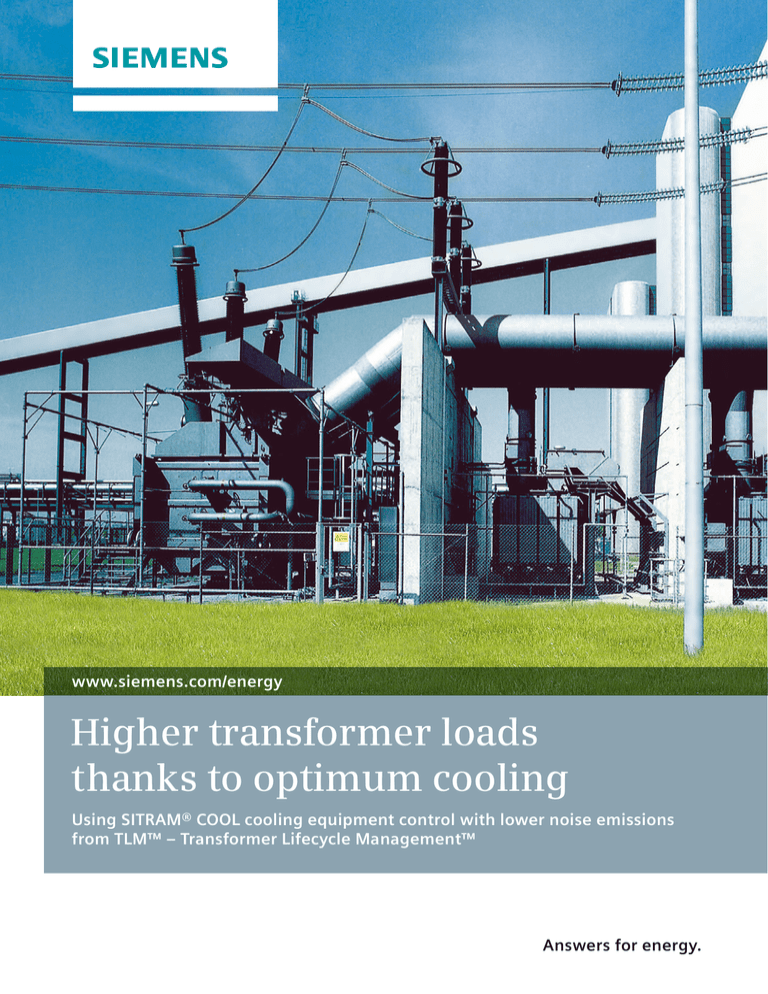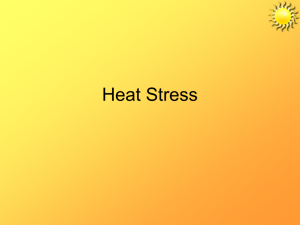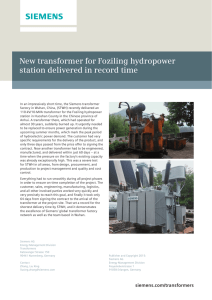
www.siemens.com/energy
Higher transformer loads
thanks to optimum cooling
Using SITRAM® COOL cooling equipment control with lower noise emissions
from TLM™ – Transformer Lifecycle Management™
Answers for energy.
SITRAM® COOL offers
situational control of fans –
individually or as a group
A cool calculation: Optimum settings
for higher loads and less noise
Transformers are key components of the electric power
grid. This means that failures come at a high cost.
One important criterion for the useful life of a transformer is temperature, which rises as loads increase.
Smart transformer cooling is not a simple matter, given
the many variables involved. In addition to fluctuating
ambient temperatures and load currents, compliance
with noise protection laws is also required – while
simultaneously keeping the inherent losses of the
cooling equipment as low as possible.
To keep the transformer cool enough while si multaneously minimizing noise and the cooling equipment’s own
requirements, we offer SITRAM® COOL, a complete smart
cooling control solution.
SITRAM® COOL contains the engineering for analyzing
cooling equipment along with the usual control and program elements. We use speed-controlled fans to minimize
noise and to minimize the cooling equipment’s own requirements. And all of this is individually adapted to your
transformer.
SITRAM® COOL also protects transformers
in the expanded operating range.
Thanks to SITRAM® CM, the optional monitoring system,
all relevant parameters can also be viewed, supervised,
and evaluated using remote servicing. Various communication interfaces naturally allow them to be retrieved
“remotely” as well.
Thanks to SITRAM® COOL …
you will increase loads by optimizing your cooling
equipment.
oil can be precooled when peak loads are anticipated.
you will optimize the inherent losses of the cooling
equipment.
you will reduce noise levels by individually switching
cooling units and using speed-controlled fans.
a constant oil temperature reduces the respiration of
the transformer.
you will have cooling equipment control, including
engineering/retrofitting of the cooling equipment, that
is tailored to your needs.
H x gr
Top oil
Tank height
Oil mix temp.
Temperature distribution
in transformer according
to IEC 60076-7
Hot-spot
gr
Tank temp.
Average winding temp.
Bottom oil
Temperature profile
Know what’s happening in your transformer
Thermal distribution in the transformer
Current standards such as IEC 60076-7 and the technical
literature assume that there is a linear increase in the oil
temperature within the tank from the bottom to the top.
The excess temperature of the conductor increases in parallel to the excess temperature of the oil with a constant
difference.
Development of hot-spots
due to increased flux leakage
At some places, known as hot-spots, the temperature is
higher than the excess temperature of the conductor at
the upper edge of the winding, which is shown by hotspot factor H. The cause of this is the magnetic flux leakage, which locally increases flux density and dissipated
heat. Fluctuations in the local oil flow can also be responsible for this.
Insulation ages fastest where the temperature is highest,
in other words at the hot-spot. The aim is to use
ap­propriate cooling to minimize that temperature.
Winding
SITRAM® COOL is part of TLM™ – Transformer Lifecycle Management™
and helps to minimize temperatures in spite of higher loads.
Speed-controlled fans
Fans
n
[1/min]
Vtotal
[m³/h]
Ptotal
[kW]
L Wtotal
[dB]
V
[m³/h]
P1
[kW]
LW
[dB]
8
1,240
192,000
15.92
89
24,000
1.99
80
4
1,240
96,000
7.96
86
21,500
1.39
77
5
1,050
100,000
6.3
83
20,000
1.26
76
6
950
108,000
5.64
82
18,000
0.94
74
SITRAM® COOL can easily coordinate the number of active fans, cooling power,
noise emissions, and intrinsic consumption
Minimizing noise and the intrinsic consumption of the
cooling equipment
Noise avoidance measures are required by law. Possible
approaches include using quieter equipment or appropriate insulation. However, costs can skyrocket as the noise
level increases, while the actual noise reduction that is
achieved tapers off.
The sound pressure level shows how loud a sound is. It
corresponds to the logarithm of the sound pressure in
relation to the reference sound pressure, the hearing
level, so two noise levels cannot simply be added together.
This means that +3 dB corresponds to a sound source that
is twice as loud, while +7 dB means that the sound source
is five times as loud.
Various countries prohibit exceeding specific noise levels,
such as 50 dB during the day and 35 dB at night, in exclusively residential areas. The guidelines are based on exposure, which means that all noise-emitting equipment must
comply with the limit values at a residence.
Change in noise pressure level
30
20
10
0
-10
-20
0.5
1
1.5
2
2.5
3
Factor of rotation speed change
The rotation speed of the cooling fans has a
strong effect on noise emissions
Another possibility is to run more fans at a lower rotation
speed. The table clearly shows that a lower speed reduces
the noise level and the inherent losses compared with four
fans.
An enhanced cooling equipment with smart fan controls
optimizes the cooling capacity in relation to the noise
emission. The design of the cooling equipment is based
on the required cooling power, the available space, and
applicable noise limits.
Fan noise is produced as a function of circumferential
speed and blade design. Staggered fan activation and the
adjustment of rotation speed when preset limit values are
reached offer numerous possibilities for reducing noise
emissions.
The volumetric flow that is responsible for cooling power
is proportional to the rotation speed, while the cooling
equipment’s own requirements are cubed. As shown by
the graphic, doubling the rotation speed increases the
noise level by 15 dB.
The transformer in the example above is equipped with
eight fans. At the temperature that is currently set, cooling power of approximately 100,000 m³/h is sufficient.
That volumetric flow rate can be achieved by switching
off four fans if the other fans operate at full speed.
TLM@siemens.com www.siemens.com/energy/TLM
SITRAM® COOL –
a solution as flexible as its modules
SITRAM® COOL is made up of multiple modules that are
independent of each other and yet coordinated with each
other. That makes it possible to produce a custom solution
for every customer, every transformer, and every plant.
Staggered activation of the fans begins when a predefined
limit value is reached. Cooling power can be further
increased by raising the rotation speed, either
stepwise or proportionally.
Diverse activation options
Smart switching
Fans are preferably activated using the load current as a
switch-on value and the hot-spot or top-oil temperature as
a switch-off value. Cooling of the transformer begins as
soon as the higher load current is applied, but it is not
switched off again until the oil has truly cooled.
The fans are deactivated when the level falls below the
switch-off value. Hysteresis is simulated using different
switch-on and switch-off values. This prevents the fans
from continuously switching on and off when the parameter value (temperature or current) fluctuates around the
switch-on value.
Other approaches are available depending on
requirements.
With the hot-spot temperature method, the fans are activated as a function of the hot-spot temperature at the critical location in the winding.
An alternative to that is controlling by the load current.
This allows cooling even before the oil heats up.
The differential temperature method can be used for
applications that are subject to large fluctuations in the
ambient temperature. The difference between the oil temperature and the ambient temperature is kept as constant
as possible, thereby minimizing respiration of the
transformer.
1
Increased reliability
Like the other parameters, failure handling can also be
adapted to the individual application. The fan rotation
speed is increased to a predefined level if a temperature
or current sensor fails or if the fans are no longer receiving a signal from the control unit.
The rotation speed of the other fans is also increased if
there is no response to the control unit by the activated
fans.
Published by and copyright © 2013
Siemens AG
Energy Sector
Freyeslebenstr. 1
91058 Erlangen, Germany
Siemens Energy, Inc.
7000 Siemens Road
Wendell, North Carolina 27591 USA
www.usa.siemens.com/energy
Siemens AG
Energy Sector
Transformer Lifecycle Management™
Katzwanger Str. 150
90461 Nuremberg, Germany
E-mail: TLM@siemens.com
www.siemens.com/energy/TLM
For more information, contact our
Customer Support Center.
Phone:+49 180/524 70 00
Fax: +49 180/524 24 71
(Charges depending on provider)
E-mail: support.energy@siemens.com
Power Transmission Division
Order No. E50001-G640-A192-V1-4A00
Printed in Germany
Dispo 19200, c4bs No. 7487
GB 130253 473400 WS 04131.
Printed on elementary chlorine-free bleached paper.
All rights reserved.
Trademarks mentioned in this document are
the property of Siemens AG, its affiliates, or their
respective owners.
Subject to change without prior notice.
The information in this document contains general
descriptions of the technical options available,
which may not apply in all cases. The required
technical options should therefore be specified
in the contract.






